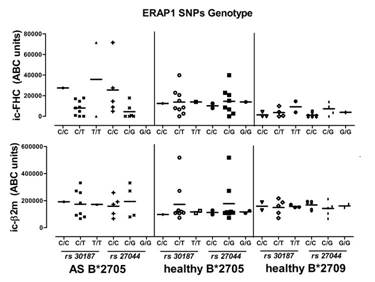Session Information
Session Type: Abstract Submissions (ACR)
Background/Purpose : Ankylosing Spondylitis (AS) is a chronic inflammatory disease of the spine strongly associated with the majority of HLA-B27 alleles, with the exception of B*2709 and B*2706. Genome wide association studies (GWAS) have revealed that besides HLA-B27, other genes are involved in AS pathogenesis, such as ERAP1, an ER aminopeptidase that is implicated in peptide trimming thus influencing B27-peptide-β2microglobulin (β2m) complex stability. Several theories have been proposed to explain the B27 association with AS. Among them, the unfolded protein response (UPR) theory suggests that the tendency of B27 trimeric complex to misfold determines free heavy chain (FHC) accumulation in the endoplasmic reticulum, leading to a stress response and activation of pro-inflammatory pathways.To our knowledge this is the first ex vivo study investigating the intracellular (ic) level of FHC and β2m in peripheral blood mononuclear cells (PBMC) and the possible influence of ERAP1 allelic variance in HLA-B27 positive AS patients and healthy subjects (HSs) bearing the AS-associated (B*2705) and the non-AS-associated (B*2709) allele.
Methods: The ic amount of FHC and β2m in CD14+ cells from ex vivo PBMC was evaluated in 12 HLA-B*2705 patients with AS, 12 HLA-B*2705 HSs and 12 HLA-B*2709 HSs by flow cytometry analysis. HC10 (gift of Dr. Chella David) and TU99 clone (BD Biosciences, USA) monoclonal antibodies were used to detect FHC and β2m, respectively, and quantified by comparison with standard beads (antibody binding capacity ABC units, Dako Denmark). Cells were fixed and permeabilized by the Intraprep Permeabilization technique (Beakman Coulter, USA) according to standard procedure. Patients and controls were also genotyped for two ERAP1 SNPs associated with AS (rs27044 C/G and rs30187 C/T). Optimized allelic discrimination assays were purchased from Applied Biosystem (Life Technologies, Italy). Values were expressed as mean ± standard deviation. Differences between AS patients and healthy subjects were analyzed by Mann-Whitney U test.
Results . FHC expression in AS patients was 37486 ± 30346 compared to B*2705 HSs 35673 ± 16723 and B*2709 HSs 26683 ± 10592 ABC units (p=ns). β2m quantity was also not significantly different in AS patients 174930 ± 90441 compared to B*2705 HSs 156471 ± 123855 and B*2709 HSs 153478 ± 42117 ABC units (p=ns). The majority of AS patients and HSs were heterozygous for both rs27044 (C/G) and rs30187 (C/T) SNPs; the intracellular amount of FHC and β2m in the PBMC of the analysed cohorts appeared not influenced by ERAP1 allelic distribution, as shown in the figure below:
Conclusion: This study shows equal amount of FHC and β2m in the cytoplasm of B*2705 AS patients compared to B*2705 and B*2709 healthy controls, regardless of ERAP1 allelic variance. These data, therefore, do not provide support to the UPR theory in the pathogenesis of AS.
Disclosure:
A. Cauli,
None;
G. Dessole,
None;
G. Porru,
None;
M. Piga,
None;
A. Vacca,
None;
A. Mathieu,
None.
« Back to 2014 ACR/ARHP Annual Meeting
ACR Meeting Abstracts - https://acrabstracts.org/abstract/the-amount-of-free-heavy-chain-and-%ce%b22-microglobulin-in-the-cytoplasm-of-b2705-ankylosing-spondylitis-patients-compared-to-b2705-and-b2709-healthy-subjects-does-not-support-the-upr-theory-infl/

